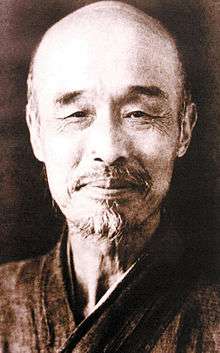Hong Yi
Hong Yi (23 October 1880 – 13 October 1942; Chinese: 弘一; pinyin: Hóngyī), born Li Shutong (李叔同) was a Chinese Buddhist monk, artist and art teacher. He also went by the names Wen Tao, Guang Hou, and Shu Tong, but was most commonly known by his Buddhist name, Hong Yi. He was a master painter, musician, dramatist, calligrapher, seal cutter, poet, and Buddhist monk.
Hong Yi | |
|---|---|
弘一 | |
 Hong Yi. | |
| Personal | |
| Born | Li Shutong(李叔同) October 23, 1880 |
| Died | October 13, 1942 (aged 61) |
| Religion | Buddhism |
| Nationality | Chinese |
| Spouse | Yu Shi Yezi |
| Children | 3 |
| Parents | Li Shizhen (李世珍) |
| School | Lǜzong |
| Lineage | 11th generation |
| Notable work(s) | Maiden Camellia Self-Portrait Songbie (song) |
| Alma mater | Furen Academy Nanyang Public School Tokyo University of the Arts |
| Temple | Kaiyuan Temple |
| Senior posting | |
| Teacher | Liaowu Master Yinguang |
Students
| |
Life

He was born in Tianjin to a banking family originating in Hongtong County, Shanxi, that migrated to Tianjin in the Ming Dynasty, though his mother was from Pinghu, Zhejiang province.[1]
In 1898 Li moved to Shanghai and joined the "Shanghai Painting and Calligraphy Association", and the "Shanghai Scholarly Society" while he was attending the Nanyang Public School (later became Jiaotong University). In 1905 Li went to Japan to study at Tokyo School of Fine Art in Ueno Park where he specialized in Western painting and music, and met a lover by the name of Yukiko who was to become his concubine.[2][3] In 1910 Li returned to China and was appointed to Tianjin's Beiyang Advanced Industry School. The next year he was appointed as a music teacher in a girls' school in Shanghai. He went to Hangzhou in 1912 and became a lecturer in the Zhejiang Secondary Normal College (now Hangzhou Normal University). He taught not only Western painting and music but also art history. By 1915 Jiang Qian hired him as a teacher at Nanjing Higher Normal School (renamed in 1949 to Nanjing University), where he taught painting and music. He also taught at Zhejiang Secondary Normal School (浙江兩級師範學堂), the predecessor of the famous Hangzhou High School.
During these later years, Li's reputation grew, as he became the first Chinese educator to use nude models in his painting classes, not to mention as the first teacher of Western music in China. Some of the students, like Singapore artist Chen Wen Hsi (陳文希)whom he personally groomed, went on to become accomplished masters of the arts in their later days. Li Shutong himself was also an accomplished composer and lyricist. Many of his compositions are still remembered and performed today.
In 1916, Li underwent a 21-day fast at a temple in Hangzhou, and experienced the benefit of a spiritual life. The following year, he took refuge in the Three Jewels of Buddhism. After spending another year there, Li began a new chapter in his life by choosing to be ordained as a monk, and thus began a holistic life dedicated to propagating Buddhism and its code of conduct. After becoming a monk he practised only calligraphy, developing a simple and unadorned, yet unique style, which was treasured by everyone who received a sample. He became known to all as Master Hong Yi. In 1942, Master Hong Yi died peacefully at the age of 61 in Quanzhou, Fujian Province.
Commemorations and Exhibitions
Beijing-based progressive-metal rock band the Tang Dynasty recorded a rock-version of Master Hong Yi's famous romantic ballad, the Farewell song in their second album Epic.[4][5]
A special 130th anniversary celebration of Master Hong Yi showcasing his calligraphy and painting works took place in 2010 in Shanghai, partly sponsored by the Pinghu Municipal Government, and attended by a granddaughter of Hong Yi.[6]
Important works
- Publications
- A Graphical Explanation of the Bhikhhu's Precepts in Dharmagupta Vinaya (Chinese: 四分律比丘戒相表記)
- The Guide to the Nanshan Vinaya for Lay Buddhists (Chinese: 南山律在家備覽)
- Collections
- Happy Stones
- Li Shutong's Seals
- Articles
- How to Paint 圖畫修得法
- An Introduction to Watercolors 水彩畫法說略
- Lyrics
- Song: Song Bie Ge (Farewell Song) 送别歌
- Music
References
- "平湖市李叔同紀念館——李叔同簡介". Phlst.cn. 2008-08-18. Archived from the original on 2011-11-25. Retrieved 2011-12-18.
- C.C. Liu (2010) A Critical History of New Music in China. The Chinese University Press, 2010 ISBN 962-996-360-4)
- Peter Micic (2009-02-15). "Li Shutong and Writing Life's Stories". Animperfectpen.blogspot.com. Retrieved 2011-12-18.
- "唐朝乐队 送别 现场版". YouTube. 2007-11-01. Retrieved 2011-12-18.
- "Kaiser Kuo Interview at the Dark Legions Archive black metal and death metal interviews". Anus.com. Archived from the original on 2012-06-23. Retrieved 2011-12-18.
- "Exhibition of Painting & Calligraphy Works of Li Shutong, Lu Weizhao and Wu Yifeng in Shanghai". English.pinghu.gov.cn. 2010-06-23. Archived from the original on 2012-04-26. Retrieved 2011-12-18.